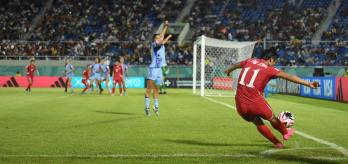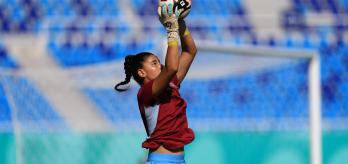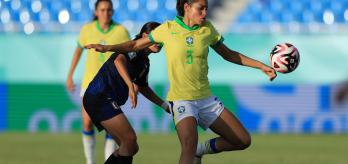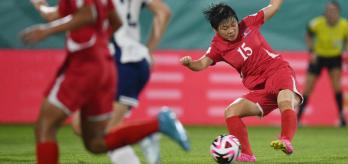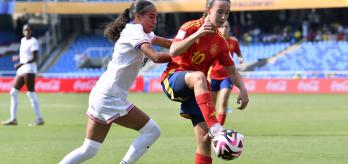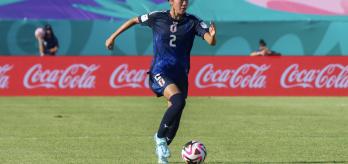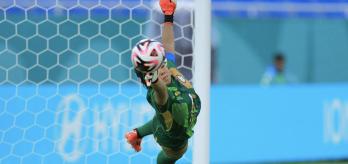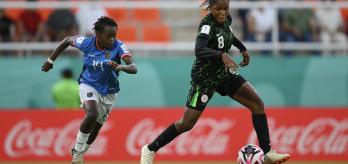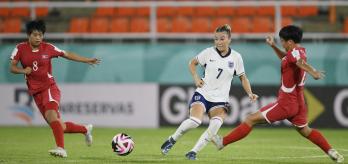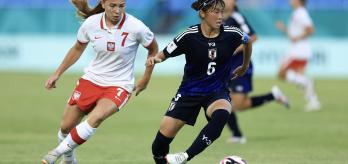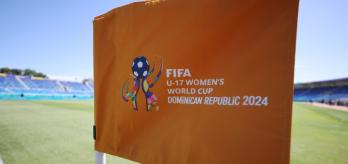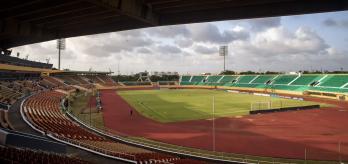During the group stage of the FIFA U-17 Women’s World Cup Dominican Republic 2024™, Technical Study Group member, Shaun Goater, recognised these attributes in Nigeria’s performances. In this article, Goater highlights their use of an out-of-possession 1-4-2-3-1 shape to play a high defensive line, which made it very difficult for their opponent’s Ecuador to get out of their own half successfully.
“Whenever Ecuador played the ball backwards or were starting play from their goalkeeper, Nigeria squeezed up and condensed the pitch. Their centre-backs were very alert to opportunities to step up and hold their defensive line on the half-way line. This meant the distances between their forward, midfield and defensive lines were short, so they always had numbers to press, counter-press and compete for second balls. Once they initiated a press, they kept competing until they won the ball back,” he explained.
As can be seen in clip 1 below, when holding their high line, Nigeria operated with a flat back four and two defensive midfielders, with a strong working relationship between their two centre-backs and the two midfielders. Any balls that came into this central territory triggered a disciplined and aggressive response, as Goater explains.
“As soon as Ecuador play the ball back to their goalkeeper, Nigeria’s back line advances with intent. This means that when the ball is played forward, they have players in close proximity to each other and can compete for the ball in numbers. They were very successful at creating a ‘block’ around the ball and smothered the space for their opponents. They were very intelligent and clever in these defensive phases with clear structure and organisation. Once they won the ball back, they had pre-planned out-ball options and demonstrated a real willingness to play forward in a controlled and measured way. Also, because of where they won the ball back, they were in a great position to play forward into dangerous areas quickly.”
In clip 2, we see another great example of how Nigeria’s defenders take on different roles as they work collectively to defend the long ball and regain possession. Starting on the half-way line, left centre-back Hannah Ibrahim (4) drops off to cover the space in case of a flick-on while right centre-back Jumai Adebayo (6) locks on to Ecuador’s centre-forward. The work ethic and understanding of roles between the two defensive midfielders here are also very important, as they pick up opposition players, but stay close to each other to protect the space. As soon as they win the ball back, their left-back Onyedikachi Ekezie (13) is released into space as they launch an immediate attack.
“They are always on the front foot. This game plan requires a very high level of concentration and players have to be switched on consistently. They knew what was expected of each other and the levels of support they provided for each other were fantastic. For such young players, their whole mentality is impressively assertive, both in, and out of possession,” Goater added.
Defensive impact
An analysis of the tournament data up to and including all second-round matches by our Football Performance Insights Team revealed that Nigeria’s defensive line is the highest played by any team in the competition so far, both in and out of possession. When they do not have the ball, they average a defensive line height of 40 metres, 4.9 metres more than the average. Nigeria are also the fourth most effective team at catching the opposition offside.
As we have seen in the clips, Nigeria are very effective at initiating pressure and pushing on to support that press until they win the ball back. In fact, they are the number one ranked team to date for push-ons leading to an interception, and have made 15 interceptions from 125 push-ons, averaging just 8.3 of these collective maneuvers per interception. Their success in this area is a testament to their decision-making at the team level.
Individually, the impact of their two centre-backs is also reflected in the performance data. Right centre-back Adebayo is the joint-top ranked player for interceptions of the ball retained (four) and has performed the highest number of sprints (12) of all centre-backs in the tournament so far. Left centre-back Ibrahim is the tournament’s second-highest ranked player for possession regains in the opposition’s half with 14, while her team-mate, centre-midfielder Taiwo Afolabi (10), ranks first with 15.
Nigeria’s positive approach to playing forward when they win the ball back is also reflected in the fact that they are the tournament’s second-highest ranked team for forward passes per 30 minutes in possession, with an 84.3% completion rate.
Technical attributes
While Nigeria’s tactical strategy was effective, the technical attributes of their players when performing their roles were vitally important in the team’s successes. Here, Goater highlights some of the technical nuances that made a difference in key moments.
Body position
The adaptations to the body shapes and positioning of the centre-backs at various moments in the passages of play demonstrated that these players were in tune with what different situations were asking of them as defenders. There was real game intelligence in how they could anticipate and judge balls that would come over the top. In these situations, they were able to get into the side-on position, ready to make the runs in behind when needed, and when the ball was played in front of them they were front facing, poised to attack. If one centre-back was stepping in to attack the ball, the other dropped off to cover the space in behind; at times the two centre-backs displayed great positional acumen by adjusting their body shape based on the danger. They were so assertive and showed great understanding and ability to read situations for such young players.
In clip 3 below, Goater highlights the understanding of how and when to position in relation to the danger and the attitude displayed to defend on the front foot.
“The anticipation of the two centre-backs here is really good. As left centre-back Ibrahim comes to press the ball, the body shape of Adebayo is really good. She is open and ready to cover the space in behind, but she is also aware of the danger in behind her, as the centre-forward tries to operate on her blindside. This means she can shadow run with the forward but also has a two-yard advantage if the ball goes into the space in behind. This is an advanced level of understanding and anticipation.
“Defenders have to be really switched on for balls over the top and down the side because this is the weak point when playing this high a line. If defenders are not quick in pace, they must be quick in thought to be able to cover the ground, but the two centre-backs were good in these situations,” he added.
Playing on the front-foot
To defend on the front foot, players need to have the confidence to step out of their defensive line in order to challenge for the ball. This starts with mindset, but players also need to feel they can trust their team-mates behind them to cover the space they are vacating. Once they advance, they must bring physicality, discipline and technique to challenge for the ball without conceding a free kick.
When possession is regained, Nigeria also play on the front foot, looking to play forward at the earliest opportunity, without fear of taking riskier options. Because they operate with the high line, they know they can exert pressure quickly and in numbers if they lose the ball.
Goater has selected clip 4 below to highlight how Nigeria played on the front foot.
“As soon as Nigeria compete for the first ball, they continue to compete at every opportunity until they regain possession. Again, we see the high line and the controlled aggression as they duel but as soon as they win the ball back, I really like how proactive centre-back Adebayo is when she takes control of the ball. The easy ball is the one out to her left-back, but she plays a dynamic ball forward into space for her advanced midfielder, who also anticipates the pass.”
Summary
The role of both centre-back in this game plan is crucial. They have pace, defend on the front foot, adopt good body shapes, push the defensive line and have the confidence to play forward when their team regains possession. There is great trust involved with this style of play, especially for the central midfielders when they challenge for second balls, knowing their centre-backs will pull the line up and condense the space. This trust allows them to fully commit to their duels.
All of these team and individual characteristics can be seen in clip 5 below.
“I really like this clip because it shows a mentality. Nigeria’s high line is the platform for the aggression in their press and as soon as they win the ball, they have that appetite to play forward. As soon as they lose the ball, they have the space condensed and short routes to press or push on. It’s relentless. They are so assertive, so switched on, so engaged, they are always on the front foot. Playing this way takes courage, intelligence and a very high work rate. It also demands coordination and understanding of roles – the leadership shown from the centre-backs to take on the responsibility is really impressive,” Goater added.
Key take-aways
-
Playing a high line demands communication, coordination and clear understanding of roles.
-
Centre-backs must recognise the danger in relation to their position and adopt the best body shape in anticipation of that specific situation.
-
Defending on the front foot requires confidence, trust and controlled aggression when stepping out of the defensive line to challenge for the ball.
-
Once possession is regained, playing early forward passes can put the team on the front foot to attack.






